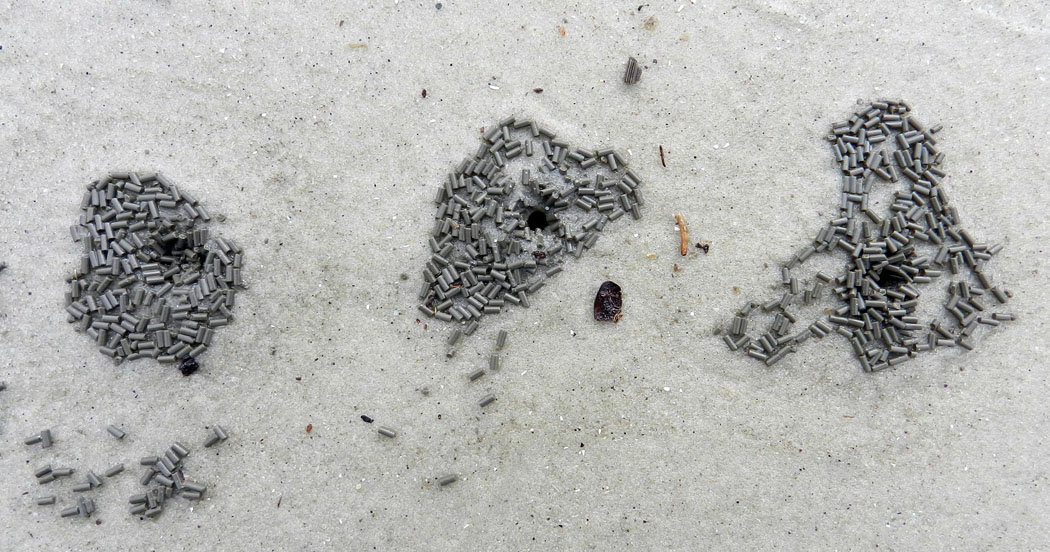Everyone poops. More specifically, every animal has to eat, converting this food into energy and otherwise applying it to bodily functions. As we also know through daily experience, this conversion is never 100% efficient. Thus waste is produced and excreted from all animal bodies, sometimes liquid, sometimes solid, or a mixture of the two.
And on the Georgia barrier islands, few animals are more visibly productive with their poop than ghost shrimp. So today’s photo and explanation celebrates those wondrous poopers of the Georgia coast.
 We three burrows of Georgia coast are adorned with feces, showing that each of us is actively occupied by a ghost shrimp. In each burrow, the shrimp is probably just below the narrow aperture, doing a little housecleaning. (Photograph by Anthony Martin, taken on Jekyll Island, Georgia.)
We three burrows of Georgia coast are adorned with feces, showing that each of us is actively occupied by a ghost shrimp. In each burrow, the shrimp is probably just below the narrow aperture, doing a little housecleaning. (Photograph by Anthony Martin, taken on Jekyll Island, Georgia.)
I’ve written previously about ghost shrimp – otherwise known as callianassid shrimp – and the significance of their burrows to ecologists, geologists, and paleontologists (linked under “Further Reading”). But I haven’t focused on one of their most important roles as ecosystem engineers, which is their prolific pooping of pellets.
These pellets are small, dark, perfectly shaped cylinders that, because of their resemblance to “chocolate sprinkles,” never fail to capture the attention of cupcake lovers as they stroll along Georgia beaches. (Now that you know what they are, please don’t eat them. Unless you like them, in which case, I’m never buying a cupcake from you.) However, aside from inspiring confectionery allusions, these pellets are extremely important in Georgia beach environments as sources of mud.
Only two species of ghost shrimp are responsible for all of this mud dumping, the Georgia ghost shrimp (Biffarius biformis) and Carolina ghost shrimp (Callichirus major). Nonetheless, they make up for their lack of diversity through sheer numbers; look closely at most Georgia beaches at low tide and you will see thousands of little “sand volcanoes,” most with pellets. Nearly all of these represent a live ghost shrimp, down below your feet, burrowing, feeding, mating, and pooping.
After feeding on mud-rich organics in their burrows, these shrimp make and emit mud-rich fecal pellets, neatly shrink-wrapped by mucus. The shrimp can then collect these packets of poop and pump them out the tops of their burrows, an efficient form of waste disposal that keeps their homes clean. These pellets become the hydrodynamic equivalent of sand grains, rolling with the tides and waves and are commonly deposited in ripple troughs and other low spots on a sandy beach.
Eventually their mucus coverings break down and release the mud particles (silt and clay), but at least these sediments were deposited. This would almost never happen on its own because of tides and waves keeping it suspended in the water, and means that the mud would be much less likely to get recycled into coastal sediments, and Georgia coastal waters would be even muddier than normal.
So take note, geologists: those thin layers of mudstone you see in the troughs of a rippled sandstone that you might just label “flaser bedding” in your field notebook, then promptly forget? Those beds probably got there by something pooping in the ancient past. And for everyone else, give thanks for these gift-wrapped feces, and for what they do for Georgia coastal environments.
Further Reading
The Lost Barrier Islands of Georgia. Written by me, posted October 3, 2011.
Ghost Shrimp Whisperer. Written by me, posted May 20, 2013.
Links to Previous Posts in This Theme
On the 12th Day of Ichnology, My Island Gave to Me: 12 Snails Grazing
On the 11th Day of Ichnology, My Island Gave to Me: 11 Plovers Probing
On the 10th Day of Ichnology, My Island Gave to Me: 10 Beetles Boring
On the 9th Day of Ichnology, My Island Gave to Me: 9 Molluscans Hiding
On the 8th Day of Ichnology, My Island Gave to Me: 8 Crab Legs Walking
On the 7th Day of Ichnology, My Island Gave to Me: 7 Lizards Looping
On the 6th Day of Ichnology, My Island Gave to Me: 6 Hatchlings Crawling
On the 5th Day of Ichnology, My Island Gave to Me: 5 Bivalves Drilling
On the 4th Day of Ichnology, My Island Gave to Me: 4 ‘Gators Denning
